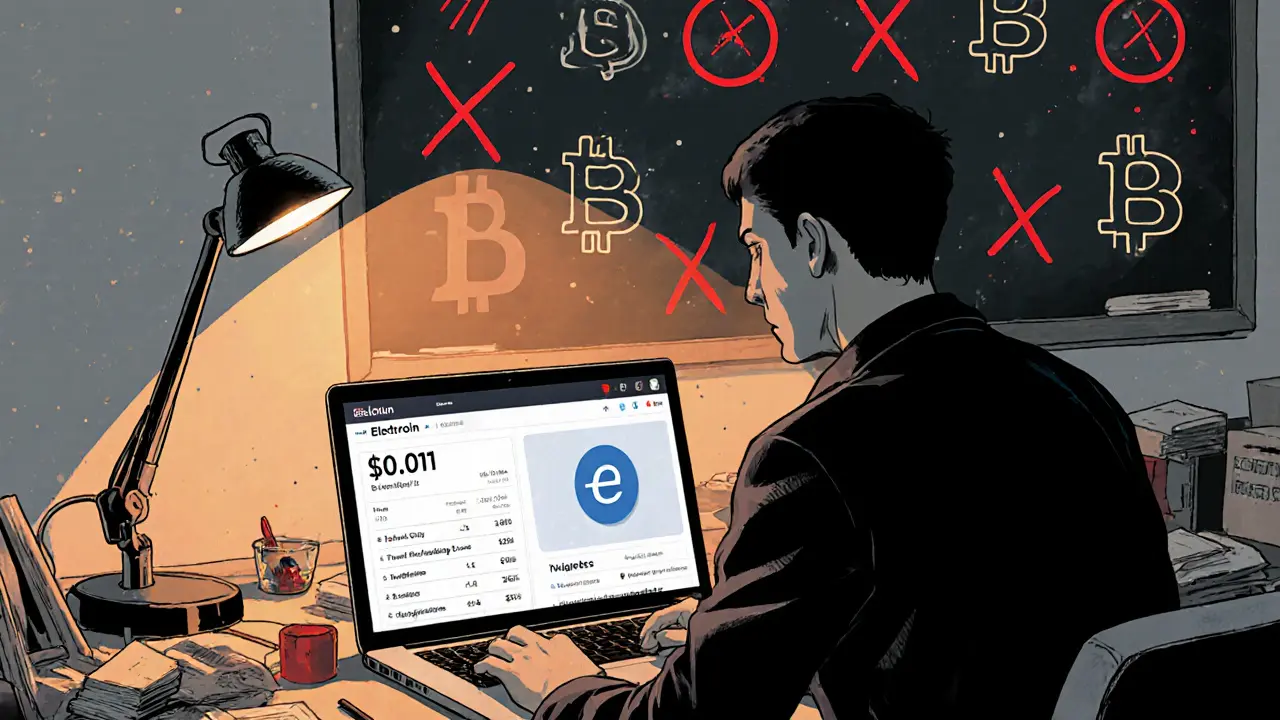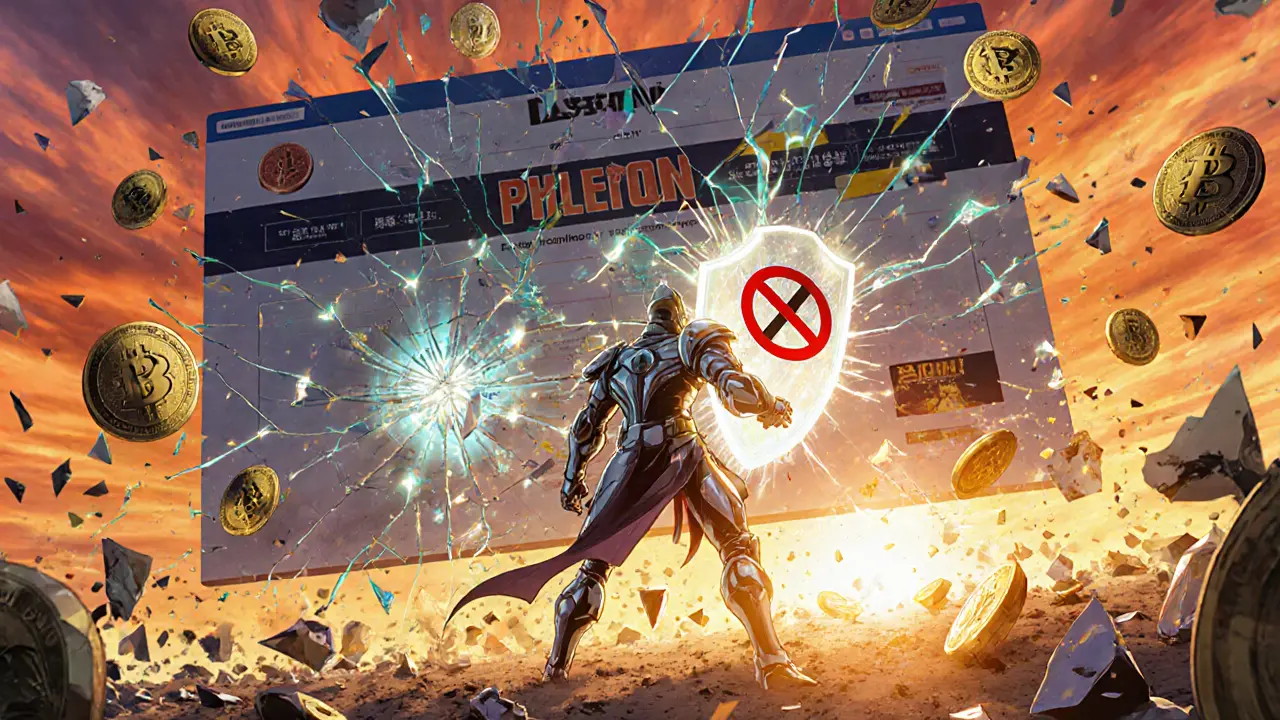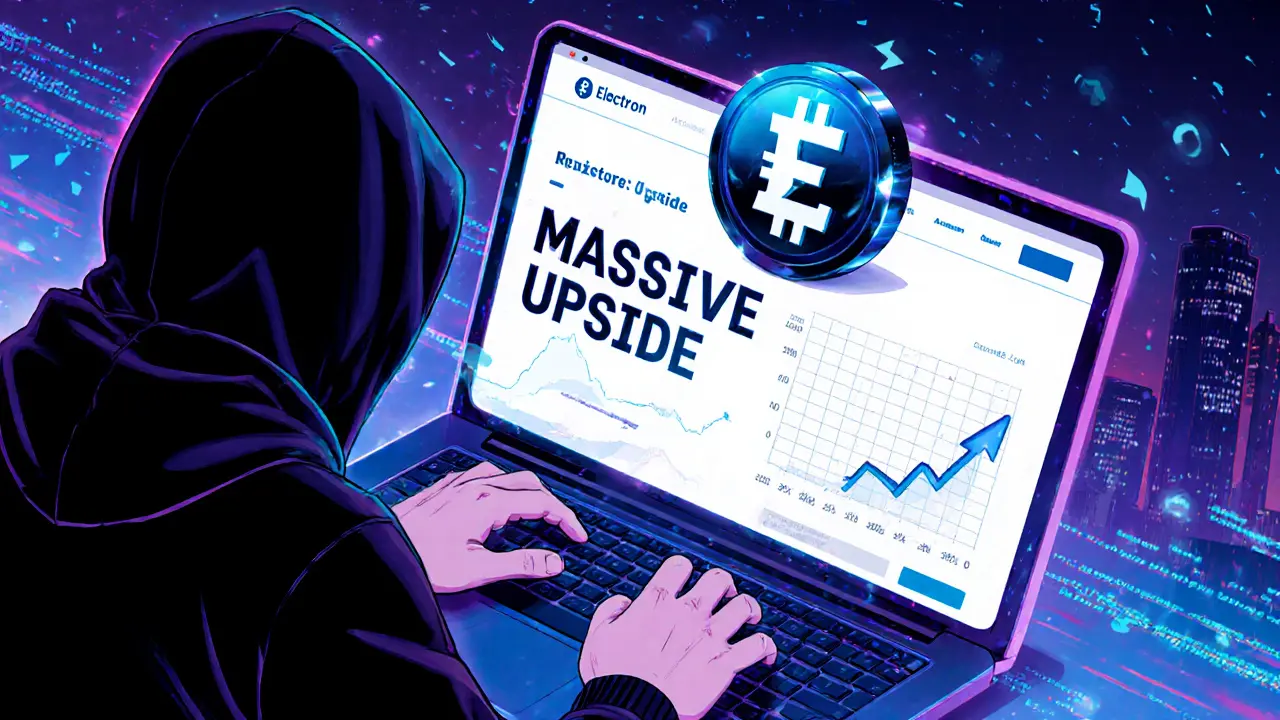Cryptocurrency Scam Checker
Enter a cryptocurrency name or symbol to check its legitimacy.
When you see Electron (ELECTRON) described as a Bitcoin‑named cryptocurrency token, you might wonder if it’s a legit Bitcoin variant or just a flashy name‑squat. The short answer: it’s a ghost token with no real market, no blockchain, and a name designed to confuse investors.
Key Takeaways
- Electron (ELECTRON) has $0 market cap, zero trading volume and no circulating supply.
- Its "Bitcoin" label is misleading; there is no technical connection to the Bitcoin network.
- Major platforms like Binance list it only as a data placeholder, not a tradable asset.
- Experts and regulators flag it as a typical scam or "zombie" token.
- Buying or interacting with ELECTRON would likely expose you to phishing or fraud.
What Is Electron (ELECTRON)?
The token marketed as Electron crypto appears on price‑tracking sites with a quoted price of around $0.0011 USD, but the figures are generated by automated scrapers-not by any real trades. Binance’s own listing (updated 14 Oct 2025) shows:
- Price: $0.001131 USD
- 24‑hour change: +0.51 %
- Market cap: $0
- Volume: $0
- Circulating supply: 0
CoinMarketCap mirrors these numbers, confirming the token’s inactivity. The contract address displayed on Binance (starting with 536737…8e90i0) does not follow Bitcoin’s usual address formats (1, 3, bc1). It likely belongs to an ERC‑20‑style deployment on Ethereum, yet the address is incomplete, making verification impossible.
Why It’s Not Bitcoin
Bitcoin runs on a proof‑of‑work network, has a capped supply of 21 million coins, processes ~300,000 transactions daily and boasts a market cap above $500 billion. ELECTRON offers none of these. There is no blockchain explorer data, no node count, no developer repo, and no documented consensus mechanism. In short, the name is pure noise.
Red Flags and Expert Opinions
Multiple authorities warn that tokens borrowing famous names are usually scams:
- The U.S. SEC’s 2022 Crypto Asset Warning Bulletin calls this practice “name squatting.”
- Dr. Garrick Hileman, Cambridge Centre for Alternative Finance, notes that tokens with major brand names but no technical documentation are "almost always attempts to exploit search algorithms."
- Chainalysis classifies zero‑volume tokens as "zombie assets" that exist only for price‑tracker convenience.

Market Presence (Or Lack Of It)
Real cryptocurrencies, even obscure ones, show at least modest activity on decentralized exchanges (DEXs) or centralized platforms. ELECTRON, however, is listed as “Not listed” on Binance and has no liquidity pools on 1inch, Matcha, or Uniswap. No wallet provider (MetaMask, Trust Wallet, etc.) includes it in their token lists, meaning you can’t even see it in a standard app.
Social signals are equally silent. A Reddit search for "Electron Bitcoin" returns zero relevant threads, and Santiment’s social volume metrics record none. Legitimate projects typically generate at least a handful of tweets or Telegram chats; ELECTRON has none.
Comparison: Legitimate Bitcoin‑Related Projects vs. Electron
| Feature | Bitcoin (BTC) | Lightning Network | Electron (ELECTRON) |
|---|---|---|---|
| Supply cap | 21 million | Depends on BTC | 0 (no verified supply) |
| Daily transactions | ≈300 k | ≈1 M off‑chain | 0 (no blockchain data) |
| Market cap (Oct 2025) | $560 B | Integrated with BTC | $0 |
| Active development | Weekly commits | Weekly commits | None found |
| Exchange listings | Hundreds | Supported via BTC exchanges | Not listed for trading |
The table makes it clear: ELECTRON lacks every metric that defines a functional cryptocurrency.
How Scammers Use Tokens Like Electron
Scammers create “ghost” tokens, post a fake price on aggregators, and then lure investors to fake exchange sites that claim to list the token. The FBI’s 2023 Internet Crime Report recorded billions lost to such schemes, many involving mis‑named tokens that mimic well‑known assets.
Typical fraud steps:
- Publish a “price chart” on sites like CoinMarketCap.
- Share the chart on social media with promises of “massive upside”.
- Direct victims to a phishing website that pretends to be a crypto exchange.
- Collect deposits in real coins (BTC, ETH) and disappear.
If you ever encounter a site asking you to buy ELECTRON, treat it as a red flag.

Regulatory Perspective
The Reserve Bank of Australia (RBA) warns that a cryptocurrency’s value hinges solely on market demand and can drop to zero instantly. ELECTRON has already hit that zero‑value state. Moreover, the European Securities and Markets Authority (ESMA) highlighted in 2023 that automated listing bots enable “data ghosts” like ELECTRON to appear legitimate, urging tighter verification.
Under the upcoming MiCA regulations in the EU (effective Dec 2024), tokens without transparent provenance will be delisted from major platforms, likely erasing ELECTRON from price aggregators in the near future.
Bottom Line: Should You Care About Electron?
For anyone hunting real investment opportunities, Electron (ELECTRON) offers nothing but risk. It has zero liquidity, no community, no code, and a deliberately misleading name. The safest move is to ignore it completely and focus on assets with verifiable on‑chain data and active development.
Frequently Asked Questions
Is Electron (ELECTRON) a real cryptocurrency?
No. ELECTRON has no blockchain, no circulating supply, and zero trading volume. It exists only as a placeholder on a few price‑tracking sites.
Can I buy ELECTRON on Binance or any exchange?
Binance lists it as “Not listed” for trading. No reputable exchange offers a market for ELECTRON, so buying it isn’t possible through legitimate channels.
Why does the token include "Bitcoin" in its name?
The name is a classic case of “name squatting.” Scammers tack on a famous brand (Bitcoin) to confuse search results and lure uninformed investors.
Is there any official documentation or whitepaper for ELECTRON?
No credible whitepaper, GitHub repo, or developer roadmap exists. All attempts to locate such documents turn up empty.
What should I do if I encounter a site selling ELECTRON?
Treat it as a scam. Do not send any funds. Report the site to your local consumer protection agency and, if possible, to the platform hosting the fraudulent page.


8 Responses
Some people think every new token is a chance for a quick win, but the reality is far darker. When a token shows up with zero market cap and no blockchain, it’s not a hidden gem – it’s a phantom. The name "Electron" is deliberately chosen to hitch a ride on Bitcoin’s fame, hoping unsuspecting eyes will skim past the lack of substance. Look at the data: no volume, no supply, no explorer, just a number on a price‑tracker. That empty shell is exactly what the shadowy groups want, because it gives them a veil of legitimacy without any real asset. They can plaster a fake chart, post it on social media, and watch naive investors scramble. Under the surface, there’s no code, no developers, no community, just a marketing façade. Every time you see a placeholder like this, ask who benefits – it’s always the scammers. The whole ecosystem of fake listings is built by bots that fill in blanks, making the ghost appear alive. That’s why regulators keep warning about ‘name‑squatting’ tokens – they’re engineered to confuse search algorithms. The more you dig, the clearer it becomes: this token exists only in the database, not on any chain. The blockchain community has repeatedly warned that if you can’t find a GitHub repo or a whitepaper, the project is likely a mirage. You can’t trust a token that never left the developer’s IDE. The risk isn’t just financial loss; it’s also exposure to phishing sites that mimic exchanges. In short, the whole construct is a perfect storm for fraud, built on the illusion of credibility. The safest move? Stay far away and focus on assets with real, verifiable on‑chain activity.
Reading through the breakdown, it feels like the industry’s playing a long game of hide‑and‑seek. The token’s invisibility on any honest exchange is a red flag that’s hard to ignore. While the prose paints a vivid picture of deceit, the underlying data speaks louder than any narrative. The absence of a blockchain explorer entry alone should send anyone searching for truth into a skeptical mode. It’s a reminder that not all that glitters is gold, especially when the glitter is generated by bots.
Indeed, the lack of verifiable technical documentation is quite concerning. From an analytical perspective, a legitimate cryptocurrency will invariably provide a whitepaper, source‑code repository, and an active development community. The omission of these fundamental components suggests that the token does not adhere to standard best practices. Consequently, any potential investor would be prudent to conduct thorough due diligence before allocating capital.
That’s exactly why you should ignore any token with zero activity. No devs, no code, no community. Simple as that.
Looks like another ghost token.
Ah, the classic "ghost token"-how original. One would expect a novel level of ingenuity, yet here we are, presented with a completely fabricated asset that masquerades as a financial instrument. The sheer audacity of listing something with zero market cap and no blockchain is almost admirable in its stupidity. It’s a testament to how low the bar has fallen for entities seeking to profit from the uninformed. One can only marvel at the effort put into designing a product that fundamentally cannot exist.
Honestly, people need to stop glorifying these scams. It's unethical to promote something that will inevitably ruin someone's savings. 🚫💸
yeah totally get it! we gotta keep each other in check and not fall for that junk. lets stay smart & look out for each other